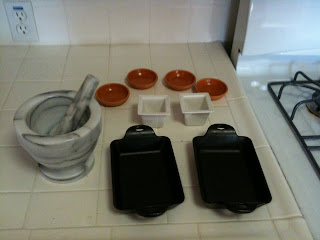When I started thinking about trying to smelt copper (the easiest of the 7 ancient metals) I found out that the mineral malachite is (was) the most common source of copper ore in the ancient world. Copper did occasionally occur in elemental form (as raw metal in the ground) but it was rare enough that it was never a staple source.
I typed "buy malachite" into
Google, and found a zillion rock shops willing to sell me 20-30mm
3 chunks of stabilized, polished malachite for $2-$3 dollars per piece, but no one (in the first 5 pages of results) selling it as a raw ore. Searching on
eBay gave the same results: polished collector samples, not ore. I changed the search to "buy rough malachite", "buy copper ore", and a bunch of new suppliers appeared, most of which wanted to sell ton quantities with multi-week delivery latencies (order it from China, they put it on a cargo vessel) with customs work and dockyard pickup.
Between those two scales, I didn't find anything.
Since my personal interests are in recreating the technologies of antiquity, I took a step back, and considered actually mining it myself. I know there are rockhound clubs that go on field trips to gather various minerals, and I've met miners/prospectors who work by themselves on small mineral lodes. If malachite was available (at the surface) in some small quantity, maybe I could go chip it out myself.
So I visited the website of my county's gem and mineral club and got the phone number of Rob, their director of field trips. It turns out that he didn't actually know how to go from a list of minerals (malachite, casserite) to a list of locations/contacts to gather those minerals. Most rock clubs' field trips are organized by members who already know a neat place to pick something up, and they go there, rather than starting with a specific mineral goal in mind and working from there.
I was undaunted. I went to
mindat.org (a really REALLY data-rich website about minerals in the US and around the world) and found they had a chat room. When I explained what I was trying to do to the local mineralogists, they were also surprised. Some of them were mineral collectors/gatherers, but they hadn't ever started out with a mineral in mind, and gone through the process of locating and getting permission to gather it. I was getting the odd feeling that this might actually be an uncommon activity. Hrm.
When in doubt, hit Google. That's my philosophy. Google disgorged contact information for the
USGS, the
Bureau of Land Management,
California Mining and Geology Board, etc. I started calling. The reaction was almost universally "You want to do
what?" Happily, someone at the department of mines pointed me to John K elsewhere at the department of conservation, and when I left a message for him, he called me back. Our conversation was great.
It turns out that yes, this really is an uncommon goal. [Sweeping generalizations follow] Individual rockhounds are usually location-based, they want to know what they can get in their local area, and they collect that. Mining concerns, in turn, have whole departments dedicated to acquiring mineral rights, and are only interested in larger prospects which make it economical to bring in heavy equipment. Between these two poles, almost no one wants to find a specific mineral and walk away with "a few pounds" of it. John took me to the amazing
USGS Mineral Resources Data System, which has a lot of useful information in it about where to find various minerals, but nothing about whether they might be gatherable. That's all up to the reader.
Likewise [more sweeping generalizations] the Bureau of Land Management allows minor mineral collection (no back hoes or explosives, please) on land it manages (you can even stake a claim) but no indication on
their maps about where minerals might be found. Aside: being a computer geek, I seriously considered making a crossover database between BLM and USGS, showing the data from both, but given that apparently the entire US market for such a database is 1 person (me) that seemed like a fruitless effort. :)
Lastly John pointed me to a couple of other less formal resources which might have people who would know more, including
Friends of Mineralogy,
I thanked John (and do so again, here, publicly: Thank you John!) and went on my way.
I contacted a couple of rock shops here in town, and started chasing down their suppliers, figuring I could track back to where the minerals they showcased were mined, or at least bought rough. This was also a little more challenging than I expected: most of those rocks you see in toy stores or oddity shops have been sold and resold several times in their polished state. Nevertheless, I eventually found a couple of semi-local (Less than 200 miles distant) places which did indeed sell 10- to 50- pound lots of several minerals. Huzzah.
Meet
Burminco and
Mineral Miners. There are probably lots of others I don't know about, but happily, suppliers like these
do exist. Please, if anyone knows of more such companies, post them here!
Likewise, if you know how to go from "mineral name" to "location and permission to gather" easily,
DEFINITELY let me know. Please.
Cheers






































